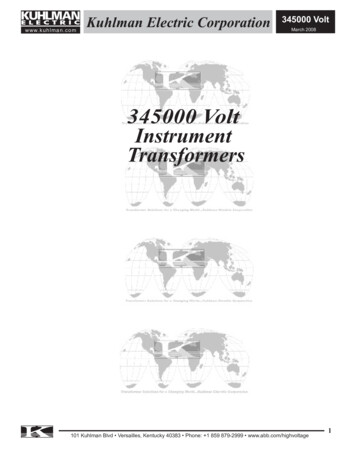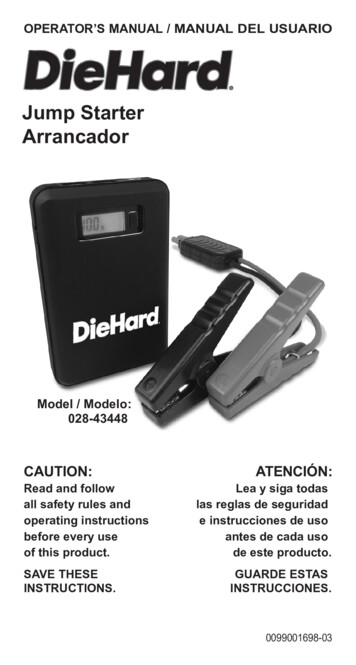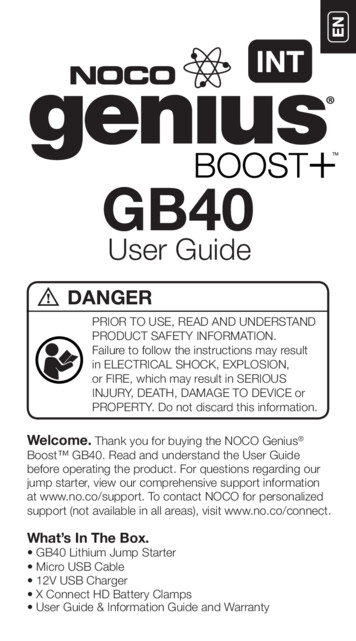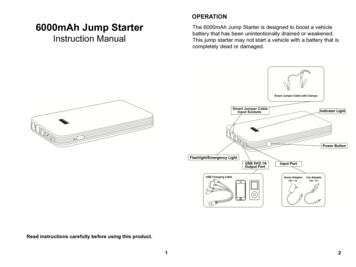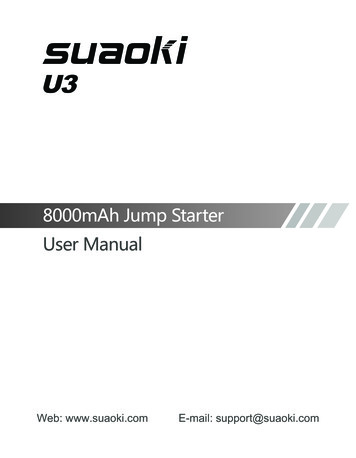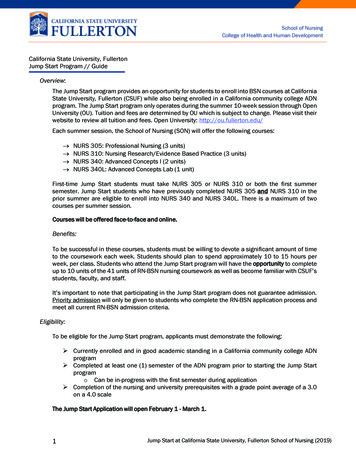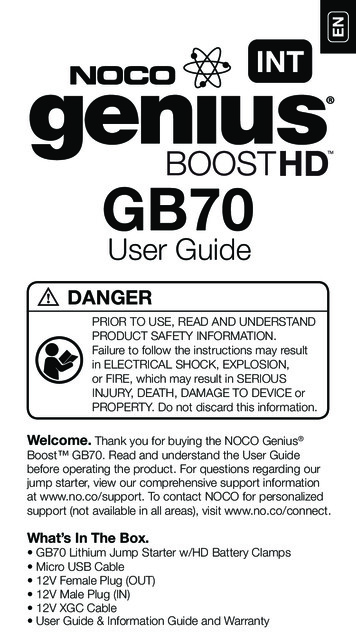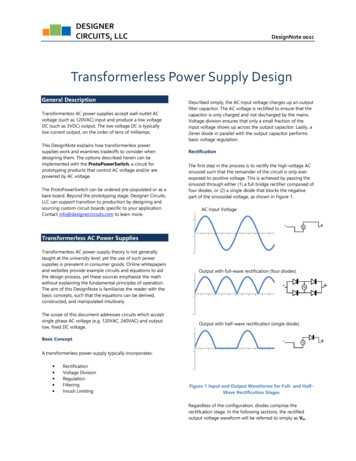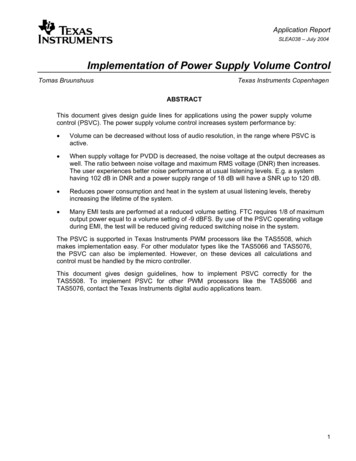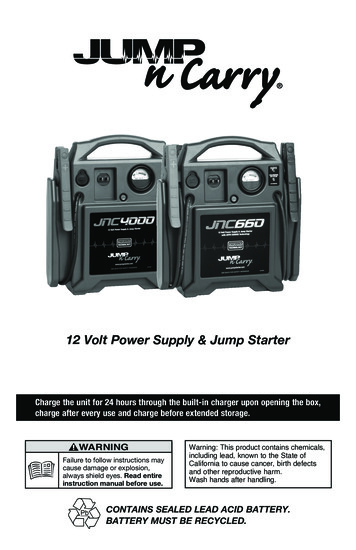
Transcription
WARNINGRead these instructions completely before using the Jump-N-Carry and save them forfuture reference. Before using the Jump-N-Carry to jump start a car, truck, boat or topower any equipment, read these instructions and the instruction manual/safetyinformation provided by the car, truck, boat or equipment manufacturer. Following allmanufacturers’ instructions and safety procedures will reduce the risk of accident.Working around lead-acid batteries may be dangerous. Lead-acid batteries releaseexplosive gases during normal operation, charging and jump starting. Carefully read andfollow these instructions for safe use. Always follow the specific instructions in thismanual and on the Jump-N-Carry each time you jump start using the Jump-N-Carry.All lead-acid batteries (car, truck and boat) produce hydrogen gas which may violentlyexplode in the presence of fire or sparks. Do not smoke, use matches or a cigarettelighter while near batteries. Do not handle the battery while wearing vinyl clothingbecause static electricity sparks are generated when vinyl clothing is rubbed. Review allcautionary material on the Jump-N-Carry and in the engine compartment.Always wear eye protection, appropriate protective clothing and other safety equipmentwhen working near lead-acid batteries. Do not touch eyes while working on or aroundlead-acid batteries.Always store clamps in their holsters, away from each other or common conductors.Improper storage of clamps may cause the clamps to come in contact with each other,or a common conductor, causing the battery to short circuit and generate high enoughheat to ignite most materials.Use extreme care while working within the engine compartment, because moving partsmay cause severe injury. Read and follow all safety instructions published in the vehicle'sOwner's Manual.While the battery in the Jump-N-Carry is a sealed unit with no free liquid acid, batteriesbeing jump started with the Jump-N-Carry unit likely contain liquid acids which arehazardous if spilled.12 Volt Power Supply & Jump StarterCharge the unit for 24 hours through the built-in charger upon opening the box,charge after every use and charge before extended storage.WARNINGFailure to follow instructions maycause damage or explosion,always shield eyes. Read entireinstruction manual before use.PbWarning: This product contains chemicals,including lead, known to the State ofCalifornia to cause cancer, birth defectsand other reproductive harm.Wash hands after handling.CONTAINS SEALED LEAD ACID BATTERY.BATTERY MUST BE RECYCLED.
Congratulations! You have just purchased a world-famous Jump-N-Carry jump starter,preferred by professionals around the world for its powerful output, exceptional servicelife and rugged design. We have taken numerous measures in quality control and in ourmanufacturing processes to ensure that your product arrives in top condition, and that itwill perform to your satisfaction.In the rare event that your Jump-N-Carry contains a damaged or missing item, does notperform as specified, or requires warranty service, please call Technical Service at (913)310-1050. Save your purchase receipt, it is required for warranty service.This unit has a sealed lead-acid battery that should be kept at full charge. Rechargewhen first purchased, immediately after each use, and every three months if not used.Failure to perform maintenance charges may cause the battery life to be reducedgreatly.Safety InformationWARNINGRead these instructions completely before using the Jump-N-Carry and save them forfuture reference. Before using the Jump-N-Carry to jump start a car, truck, boat or topower any equipment, read these instructions and the instruction manual/safetyinformation provided by the car, truck, boat or equipment manufacturer. Following allmanufacturers’ instructions and safety procedures will reduce the risk of accident.Working around lead-acid batteries may be dangerous. Lead-acid batteries releaseexplosive gases during normal operation, charging and jump starting. Carefully read andfollow these instructions for safe use. Always follow the specific instructions in thismanual and on the Jump-N-Carry each time you jump start using the Jump-N-Carry.All lead-acid batteries (car, truck and boat) produce hydrogen gas which may violentlyexplode in the presence of fire or sparks. Do not smoke, use matches or a cigarettelighter while near batteries. Do not handle the battery while wearing vinyl clothingbecause static electricity sparks are generated when vinyl clothing is rubbed. Review allcautionary material on the Jump-N-Carry and in the engine compartment.Always wear eye protection, appropriate protective clothing and other safety equipmentwhen working near lead-acid batteries. Do not touch eyes while working on or aroundlead-acid batteries.Always store clamps in their holsters, away from each other or common conductors.Improper storage of clamps may cause the clamps to come in contact with each other,or a common conductor, causing the battery to short circuit and generate high enoughheat to ignite most materials.Use extreme care while working within the engine compartment, because moving partsmay cause severe injury. Read and follow all safety instructions published in the vehicle'sOwner's Manual.While the battery in the Jump-N-Carry is a sealed unit with no free liquid acid, batteriesbeing jump started with the Jump-N-Carry unit likely contain liquid acids which arehazardous if spilled.
General precautions for use: Someone should always be within range of your voice or close enough to cometo your aid when you work near a lead-acid battery. Have plenty of fresh water and soap nearby in case battery acid contacts skin,clothing or eyes. Protective eyewear should always be worn when working nearlead-acid batteries. If battery acid contacts skin or clothing, wash immediately with soap and water.If acid enters eye, immediately flood eye with cold running water for at least 10minutes and get medical attention immediately. Be extra cautious to reduce risk of dropping a metal tool onto a battery. Itmight spark or short circuit the battery or another electrical part that may causeexplosion. Remove personal metal items such as rings, bracelets, necklaces and watcheswhen working with a lead-acid battery. A lead-acid battery can produce a shortcircuit current high enough to weld a ring or the like to metal, causing a severeburn. Use the Jump-N-Carry for jump starting lead-acid batteries only. Do not use forjump starting dry-cell batteries that are commonly used with home appliances.These batteries may burst and cause injury to persons and damage to property. NEVER charge or jump start a frozen battery. To prevent arcing, NEVER allow clamps to touch together or to contact the samepiece of metal. Use of an attachment not recommended or sold by the manufacturer may resultin a risk of damage to the unit or injury to personnel. When using the power extension cord, pull on the plug and never on the wirewhen disconnecting. Do not recharge the Jump-N-Carry with a damaged power extension cord.Replace it immediately. The Jump-N-Carry may be used under any weather condition – rain, snow, hotor cold temperatures. Do not submerge in water. Do not operate with flammables such as gasoline, etc. If the Jump-N-Carry receives a sharp blow or is otherwise damaged in any way,have it checked by a qualified service person. If the Jump-N-Carry is leakingbattery acid, do not ship it. Take it to the closest battery recycler in your area. Do not disassemble the Jump-N-Carry. Have it checked by a qualified serviceperson. The Jump-N-Carry should never be left in a completely discharged state forany period of time. Damage to the battery could be permanent, with poorperformance as a result. When not in use, recharge every three (3) months. Always store, use and charge the Jump-N-Carry in an area where childrencannot get to the unit.
Features The Jump-N-Carry provides plenty of power for starting vehicles – more thanenough to start most cars. The Jump-N-Carry will power most 12 Vdc accessories equipped with a male12 Volt plug. The DC outlet features automatic overload protection. The unit features a test switch and battery status gauge, which provides anapproximate indicator of the battery’s state of charge. The Jump-N-Carry features convenient side-mounted holsters with cable tracksfor easy cable and clamp management. Always re-wrap cables and re-holster theclamps after each use. The Jump-N-Carry contains the latest technology with its 12 Volt sealed,non-spillable battery and may be stored in any position.Battery Status GaugePress and hold the red test button to display the battery status on the gauge. The Green shaded area indicates the unit is capable of jump starting. The Yellow shaded area indicates the unit needs to be recharged. The Red shaded area indicates the unit must be recharged immediately.You can also get a quick check of the vehicle’s charging system by depressing the redtest button while connected to a running vehicle and observing the gauge.RechargingNote: Upon initial purchase, charge your Jump-N-Carry until the green CHARGED LEDlights (JNC660) or for a minimum of 24 hours (JNC4000).There are two ways to charge your Jump-N-Carry. The recommended method isrecharging using AC power, with a household extension cord connected to the built-incharger. An alternative method is through the DC power outlet using the provided 12Volt Male-Male Extension Cord. In some cases, care must be taken not to overchargethe Jump-N-Carry, as noted.Charging using the built-in charger (recommended method). With this method, anextension cord (not included) is connected to the Jump-N-Carry through the built-incharger located on the front of the unit.1. Connect the female end of the extension cord to the charger plug on the front ofthe unit. The charger plug has two blades and resembles a standard householdplug that would fit into a 120 Vac wall receptacle.2. Connect the male end to the extension cord to the AC outlet.- an amber LED will light to show the charging phase is in process. (JNC660 only)3. Charge until the green LED lights to show that the charging process is completeand has entered maintenance mode (new style JNC660 models only) or as notedin the following table (JNC4000 and old style - no LED indicators - JNC660models).
SUGGESTED AC RECHARGE TIMES (JNC4000 and older JNC660 models)After a single jump start:1 hourAfter multiple jump starts:12 hours or overnightAfter using as portable power:24-36 hoursNote: We do not recommend charging the unit for more than 24 hours undernormal usage. However, under extreme usage or high discharge situations, rechargethe unit for up to 36 hours. This is not applicable to JNC660 models with autocharging, which cannot be overcharged. These models can remain connectedcontinuously with no adverse consequences.Charging using the supplied 12 Volt Male-Male Extension Cord. This alternative chargingmethod may be used when access to an AC outlet is unavailable.1. Start the vehicle’s engine.2. Plug one end of the 12 Volt Male-Male Extension Cord into the Jump-N-Carry12 Volt outlet and the other end into the vehicle’s 12 Volt power port.3. Charge the unit based on the suggested recharge times shown in the followingtable.SUGGESTED 12 VOLT RECHARGE TIMESAfter jump starting:20 minutesAfter using as portable power:2 hoursAfter high discharge conditions:5 hoursNote: DO NOT OVERCHARGE! You must frequently monitor the charging processto ensure the unit is not overcharged. Overcharging will damage your Jump-N-Carry.Jump Starting InstructionsNote: For optimum performance, do not store your Jump-N-Carry below 50 F whenusing as a jump starter. NEVER charge or jump start a frozen battery.1. Use in a well ventilated area.2. Shield eyes. Always wear protective eyewear when working near batteries.3. Review this instruction manual and the instruction/safety manual provided by themanufacturer of the vehicle being jump started.4. Turn ignition off before making cable connections.5. Clamp the positive (red ) clamp to the positive terminal on the vehiclebattery (for negative ground system), or an alternate vehicle starting point asrecommended by vehicle manufacturer.6. Clamp the negative (black –) clamp to the vehicle ground (non-moving metal part,such as the vehicle frame).7. Make sure the cables are not in the path of moving engine parts (belts, fans,etc.).8. Stay clear of batteries while jump starting.
9. Start the vehicle (turn on the vehicle ignition).Note: If the vehicle doesn’t start within 6 seconds, let the Jump-N-Carry coolfor 3 minutes before attempting to start the vehicle again or you may damage theJump-N-Carry.10. When the vehicle is started, disconnect the negative (–) battery clamp from thevehicle frame and return it to its holsters.11. Disconnect the positive ( ) clamp and return it to its holster.12 Volt DC PowerYour Jump-N-Carry is an essential tool for all who replace automobile batteries.Most vehicles have electronic components with memory, such as alarm systems,computers, radios, phones, etc. and when the vehicle’s battery is replaced, the memoryis lost. However, if the Male-Male Extension Cord is connected from the Jump-N-Carryto the 12 Volt outlet on the vehicle, the memory can be saved.Note: To use the Jump-N-Carry for this purpose, the chosen outlet must be live whenthe vehicle is turned OFF. On some vehicles, 12 Volt outlets are deactivated when thevehicle is turned OFF.Your Jump-N-Carry is also a portable power source for all 12 Vdc accessoriesequipped with a male 12 Volt plug. The DC outlet on the Jump-N-Carry has automaticoverload protection.When your Jump-N-Carry is used with a DC to AC power inverter, it can operateappliances normally powered by 120 Vac or 220 Vac. Recommended inverter for theportable power source is 400 watts maximum. For more information, contact yournearest Jump-N-Carry dealer.Performance and TemperaturePerforma
manual and on the Jump-N-Carry each time you jump start using the Jump-N-Carry. All lead-acid batteries (car, truck and boat) produce hydrogen gas which may violently explode in the presence of fire or sparks. Do not smoke, use matches or a cigarette lighter while near batteries. Do not handle the battery while wearing vinyl clothing because static electricity sparks are generated when vinyl .
